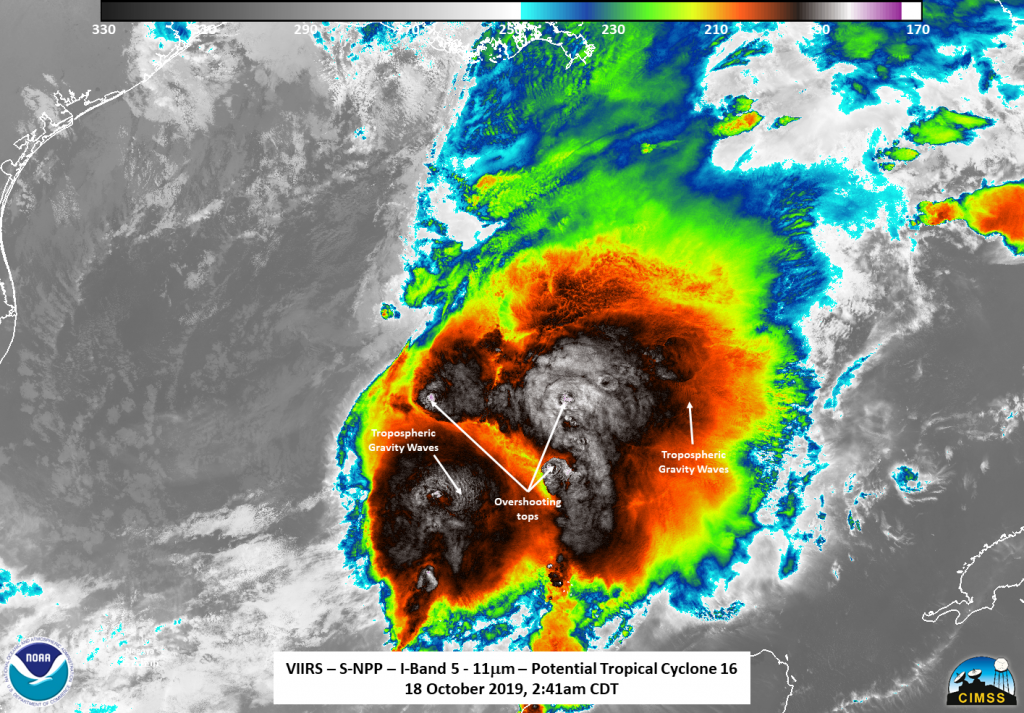Oct. 19, 2019 – NASA Finds Heaviest Rain on Tropical Storm Nestor’s Eastern Side
NASA imagery revealed that the eastern quadrant of Tropical Storm Nestor contains the storm’s heaviest rain rates. That side of the storm has been drenching Florida, as seen in a satellite image from the Global Precipitation Measurement mission or GPM core satellite on Oct. 19.

NASA has the unique capability of peering under the clouds in storms and measuring the rate in which rain is falling. GPM passed over the region from its orbit in space and measured rainfall rates in these storms.
GPM passed over the Gulf of Mexico on Oct. 19 at 3:51 a.m. EDT (0751 UTC) and provided rainfall rates in Tropical Storm Nestor. The heaviest rainfall was occurring in the eastern side of the storm, over Florida and falling at a rate of over 36 mm (about 1.4 inch) per hour and at a rate of 25 mm (about 1 inch) per hour.
Forecasters at NOAA’s National Hurricane Center or NHC incorporate the rainfall data into their forecasts. NHC said, “Nestor is expected to produce total rainfall accumulations of 2 to 4 inches this weekend across portions of the southeastern United States, with isolated maximum amounts of 8 inches.”
On Oct. 19, a Tropical Storm Warning is in effect from Florida’s Okaloosa/Walton County line to Yankeetown, Florida. A Storm Surge Warning is in effect from Indian Pass, Florida to Clearwater Beach, Florida.
At 8 a.m. EDT (1200 UTC), satellite imagery, NOAA Doppler weather radar data, and surface observations indicate that the center of Tropical Storm Nestor has redeveloped farther west near latitude 29.5 north, longitude 86.8 west. That’s just 80 miles(125 km) west-southwest of Panama City, Florida.
Nestor is moving toward the northeast near 17 mph (28 kph). A turn toward the east-northeast is forecast to occur Sunday. Doppler radar data and surface observations indicate that maximum sustained winds remain near 50 mph (85 km/h) with higher gusts.
Tropical-storm-force winds extend outward up to 160 miles (260 km) mainly to the east of the center. The minimum central pressure based on nearby surface observations is estimated to be 996 millibars.
The Tyndall Air Force Base Tower located south of Apalachicola, Florida, recently reported a sustained wind of 49 mph (80 km/h) and a gust of 61 mph (98 km/h) at an elevation of 115 feet (35 m). A National Ocean Service tide gauge at Apalachicola, Florida, recently measured a water level of 3.2 feet above Mean Higher High Water.
No change in strength is anticipated before Nestor reaches the coast, but weakening is forecast to begin after the cyclone moves inland. Nestor is expected to lose tropical characteristics and become post-tropical by early afternoon today, Oct. 19. On the forecast track, Nestor is expected to make landfall on the Florida Panhandle around mid-day, Oct. 19, and will then move across portions of the southeastern United States later today and Sunday as a post-tropical cyclone. Nestor is expected to move offshore of the coast of North Carolina into the western Atlantic by late Sunday also as a post-tropical cyclone.
Hurricanes are the most powerful weather event on Earth. NASA’s expertise in space and scientific exploration contributes to essential services provided to the American people by other federal agencies, such as hurricane weather forecasting.
For updated forecasts, visit: www.nhc.noaa.gov


